In the upcoming edition of UEFA Euro 2024, Austria will participate in Group D with France, Netherlands and Poland.
Austria has appeared in three editions of the UEFA European Championship: 2008, 2016, and 2020, with an upcoming fourth appearance in 2024.
In 2008 and 2016, they exited from the group stage, but they were eliminated by Italy in the round of 16 after extra time in 2020.
In this Euro qualification, Ralf Rangnick’s side showed a very good performance, ending second, gaining 19 points after Belgium, with only a point difference.
Sweden was third, gaining 10 points in a group containing Azerbaijan and Estonia, too.
In this very tough group, many people ask if Austria can pass the group stage for the second time in its history!! Through this analysis, we will explain their tactics in the different phases, showing their strengths and weaknesses.
We will also know how Ralf Rangnick trusts the process with Austria, which may help him decide to say no to Bayern Munich.
This scout report, in the form of a tactical analysis, will provide a detailed analysis of Austria’s tactics under Ralf Rangnick.
Predicted starting XI
Austria has predominantly relied on the 4-2-3-1 formation as their foundation, which switches to 4-4-2 in defending when Christoph Baumgartner joins the centre forward to be two in the first pressing line.
Austria suffer from percussive injuries in four of their usual starting eleven: Alexander Schlager as the usual starting goalkeeper, David Alaba, Philipp Lienhart as the usual starting CBs and Xaver Schlager as their brilliant central midfielder.
In goalkeeping, the choice ranges between Patrick Pentz, Tobias Lawal and Niklas Hedl.
However, Patrick Pentz will probably be the number one for Austria between the sticks.
The 27-year-old keeper is the most-trusted and should have the gloves in the Euro after the shocking knee injury of Austria’s number one goalkeeper, Alexander Schlager.
Meanwhile, Tobias Lawal should be the second-choice keeper.
Ralf Rangnick relies on a four-player backline.
Stefan Posch should be the first choice as the right-back, while Kevin Danso and Maximilian Wöber may be the two first-choice centre-backs.
The second one may play as a left-back, leaving the centre-back position to Leopold Querfeld or Samson Baidoo, but Phillipp Mwene is the first choice for the left-back position.
The first choice in central midfield will remain Nicolas Seiwald while there are many options for the one who will replace Xaver Schlager.
Florian Grillitsch will probably be the first choice while having the option to use one of his wingers, Konrad Laimer and Marcel Sabitzer.
Dejan Ljubicic may be an option on the bench.
The brilliant Christoph Baumgartner will probably keep his position as the central attacking midfielder, number 10.
On the flanks, Konrad Laimer and Marcel Sabitzer, both usually cut inside, are preferred for the right and left-wing positions, respectively.
The squad is full of multi-position players, and you may notice that the talented Romano Schmid may replace one of them.
Michael Gregoritsch is likely to be their number-one striker, especially after the injury of Manprit Sarkaria, who will predominantly be absent.
Muhammed Cham and Maximilian Entrup are good options on the bench.
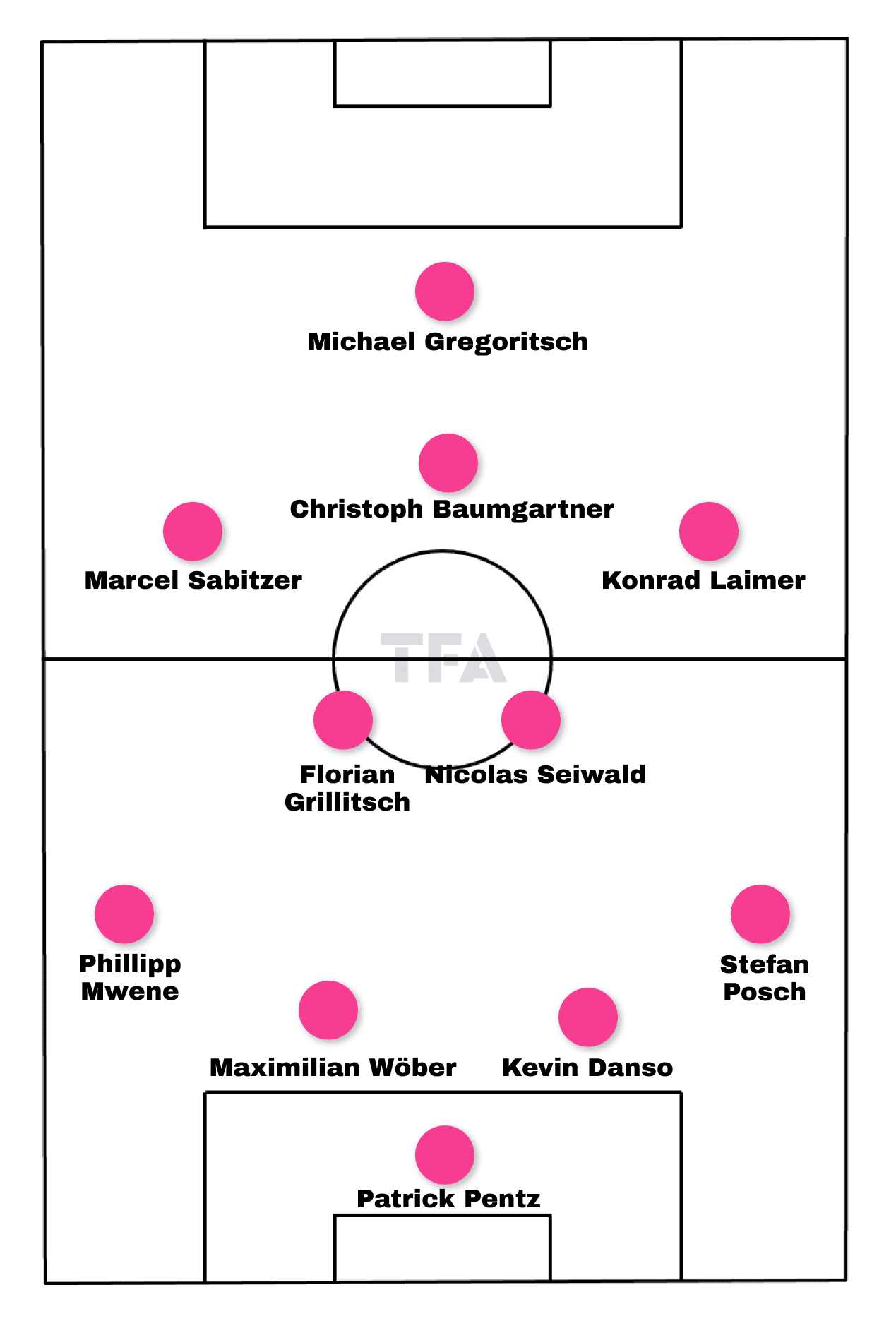
Ralf Rangnick’s possible choices’ age profile is shown below.
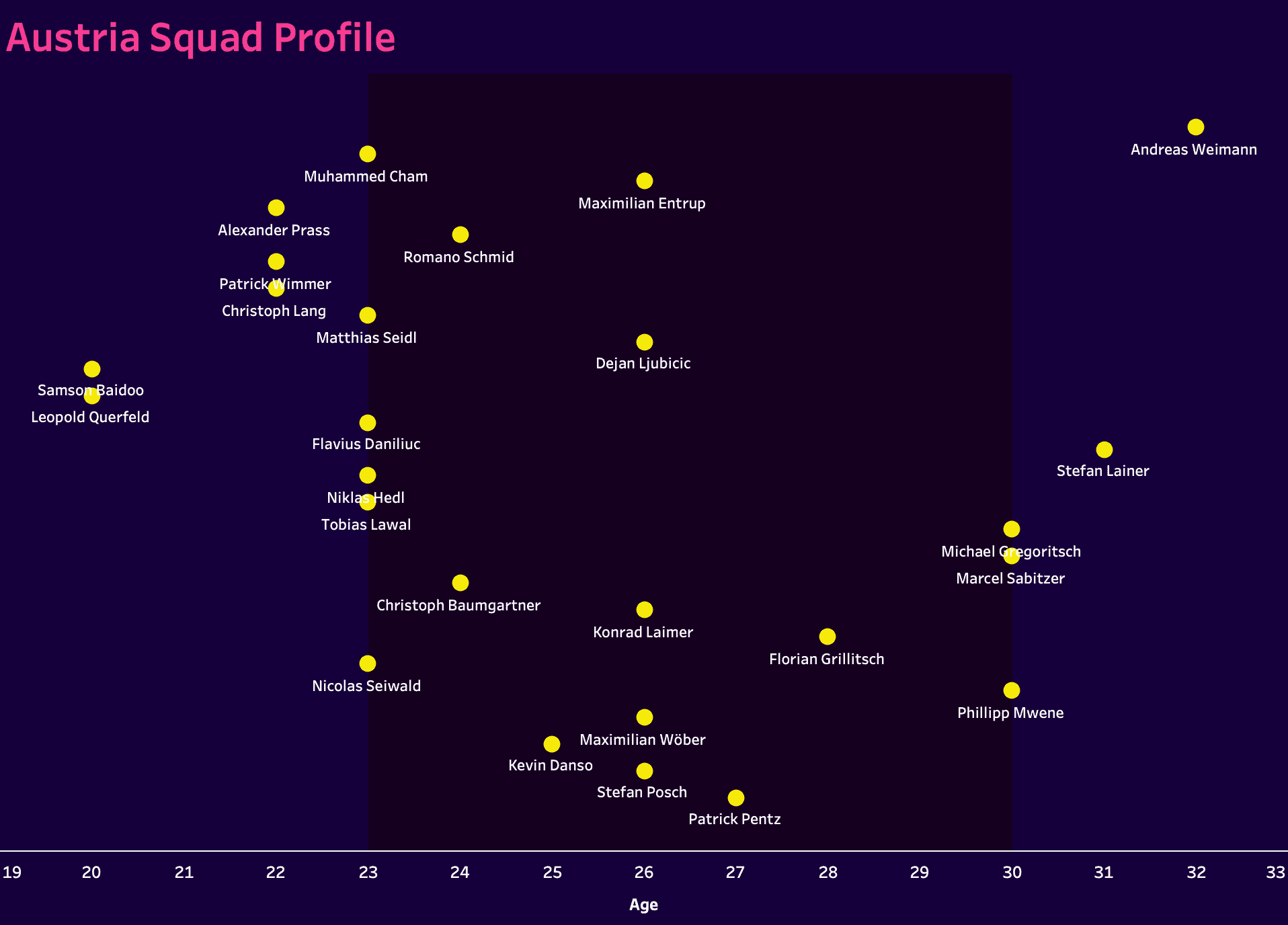
The coach’s choices are a mix of experience and youth.
The experience represented by Marcel Sabitzer and Phillipp Mwene to withstand the pressure and help the rest of the players and the youth like Christoph Baumgartner and Romano Schmid to make quick transitions on which they depend.
Attacking phase
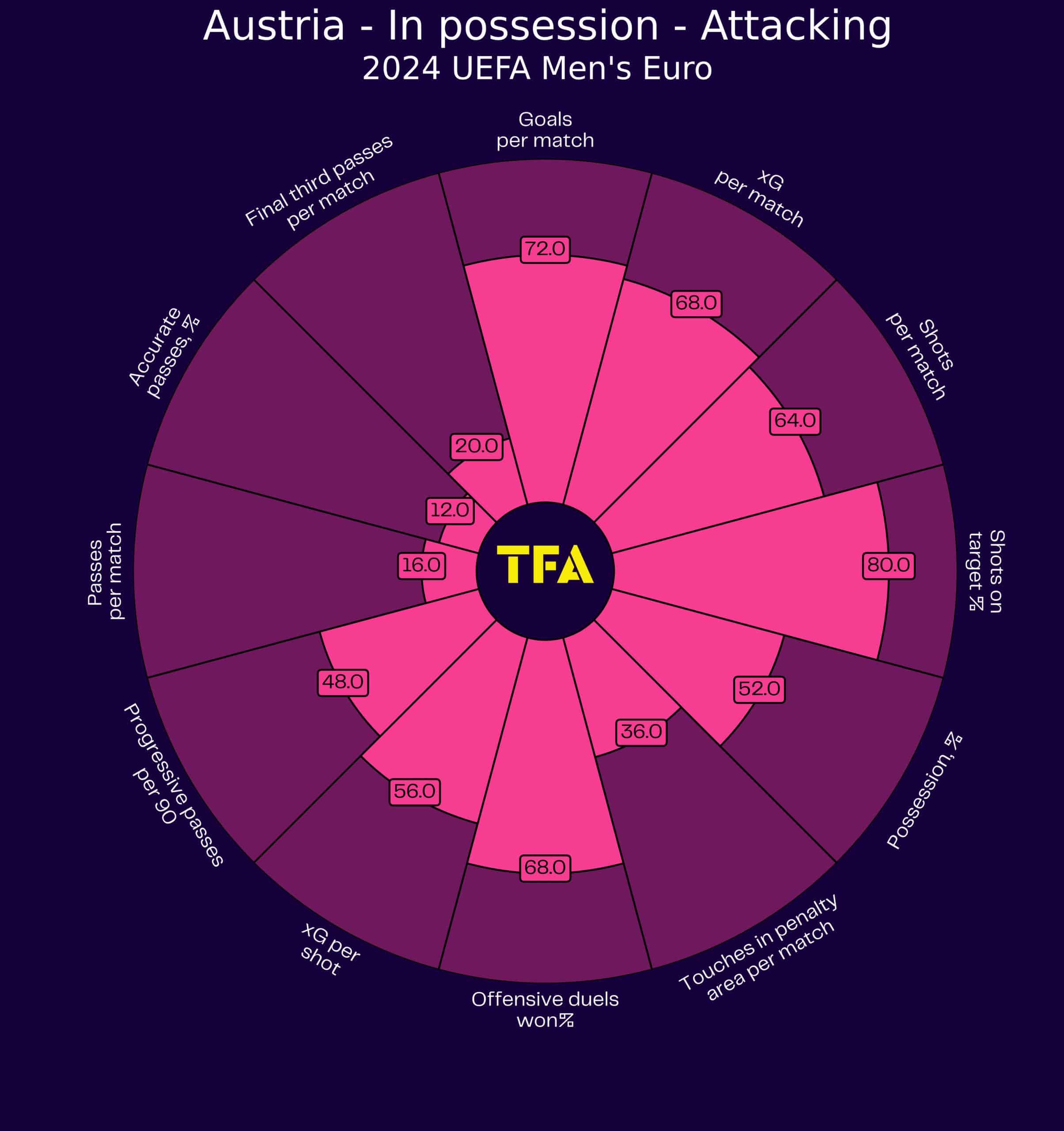
The statistical data presented offers valuable insights into the team’s playing style.
Although their goals scored and XG per match are reasonable, it is clear that keeping the possession through an organised attacking phase isn’t their preferred phase, with low numbers in final-third passes, accurate passes and passes per match.
With high numbers of shooting on target, better than 80% of teams in the qualifications, and offensive duels, we can predict that they like to play direct football with very high press and attacking transitions, as we will explain later.
In the build-up, they have a common strategy using their two central midfielders and their narrow wingers.
In the first two photos below, when the striker presses the centre-back, he passes the ball to the goalkeeper, who will use a third-man pass to pass the ball again to the centre-back, who can dribble then.
In the third photo, the opponent’s winger faces a choice to press this centre=back or keep marking the left-back.
What increases the difficulty of this decision is the narrow position of the Austrian winger, who forces the opponent’s winger to shadow him, so the opponent’s right-back is forced to press the exited, leaving the winger free, as shown in the fourth photo.
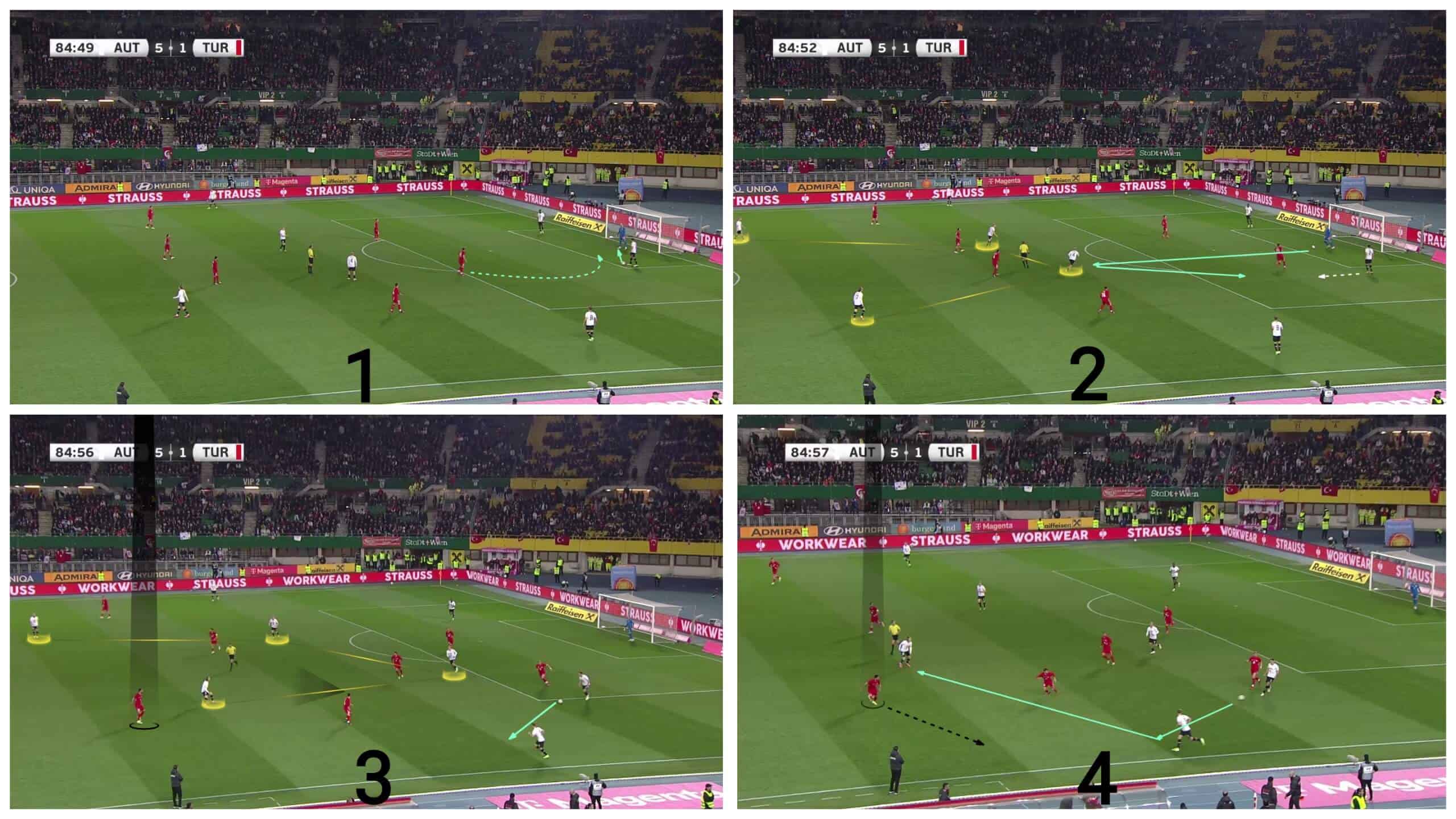
They also have a common strategy, especially against mid-blocks, which involves dropping one of the midfielders back to be three in the back line while giving the full-backs instructions to stand widely and the wingers instructions to cut inside in half-spaces.
In the photo below, Türkiye use the side-pressing strategy to press six players by five players, which frees their central defender midfielder, in green, to cover the area behind the two pressing lines and be free to follow Christoph Baumgartner, 10 position, but Austria’s left central defender midfielder drops back to be three in the back line.
Türkiye’s wingers’ mission is to press the full-back in the ball’s side while the other goes inside to press the far central midfielder.
Let’s know what happens after this trick.
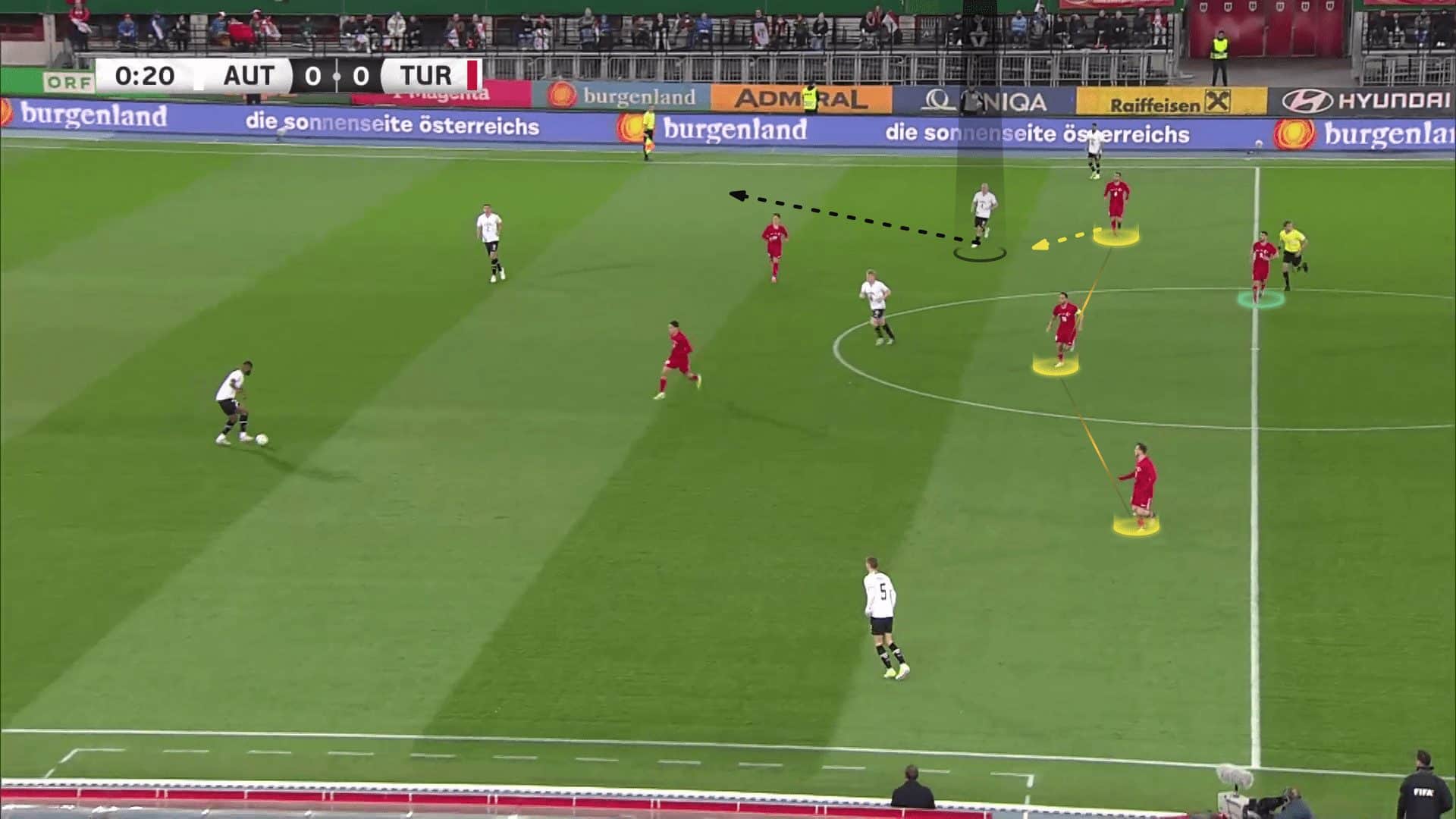
Türkiye’s right winger is forced to push up to press this midfielder, leaving the left-back free.
The two wingers stand narrowly, which forces the free defending midfielder in green to press Austria’s left winger because Türkiye’s right-back can’t press him in this narrow position, leaving the Austrian left-back free.
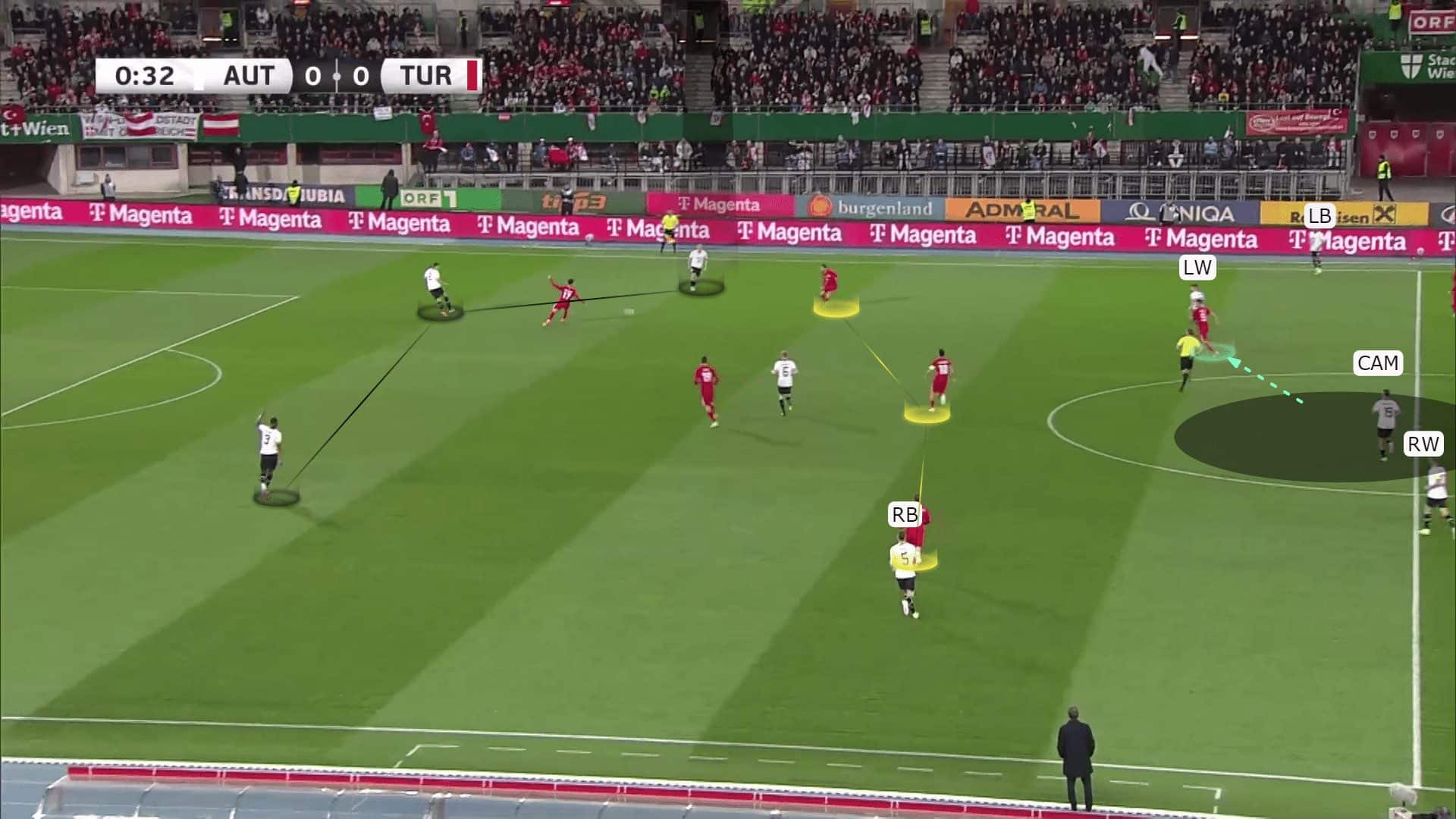
In the first photo below, the same strategy is clear, but the narrow three attackers behind them attract Belguim’s four-player second line, so they decide not to press, leaving the two forwards to apply the same six-center-back pressure, as shown in the second photo below.
In the third photo below, the Belgian black midfielder goes to help press the Austrian defender midfielder, but there is still a 2-v-1 problem facing Belguim’s right winger, so he decides not to press, leaving this large area for the full-back to run with the ball.
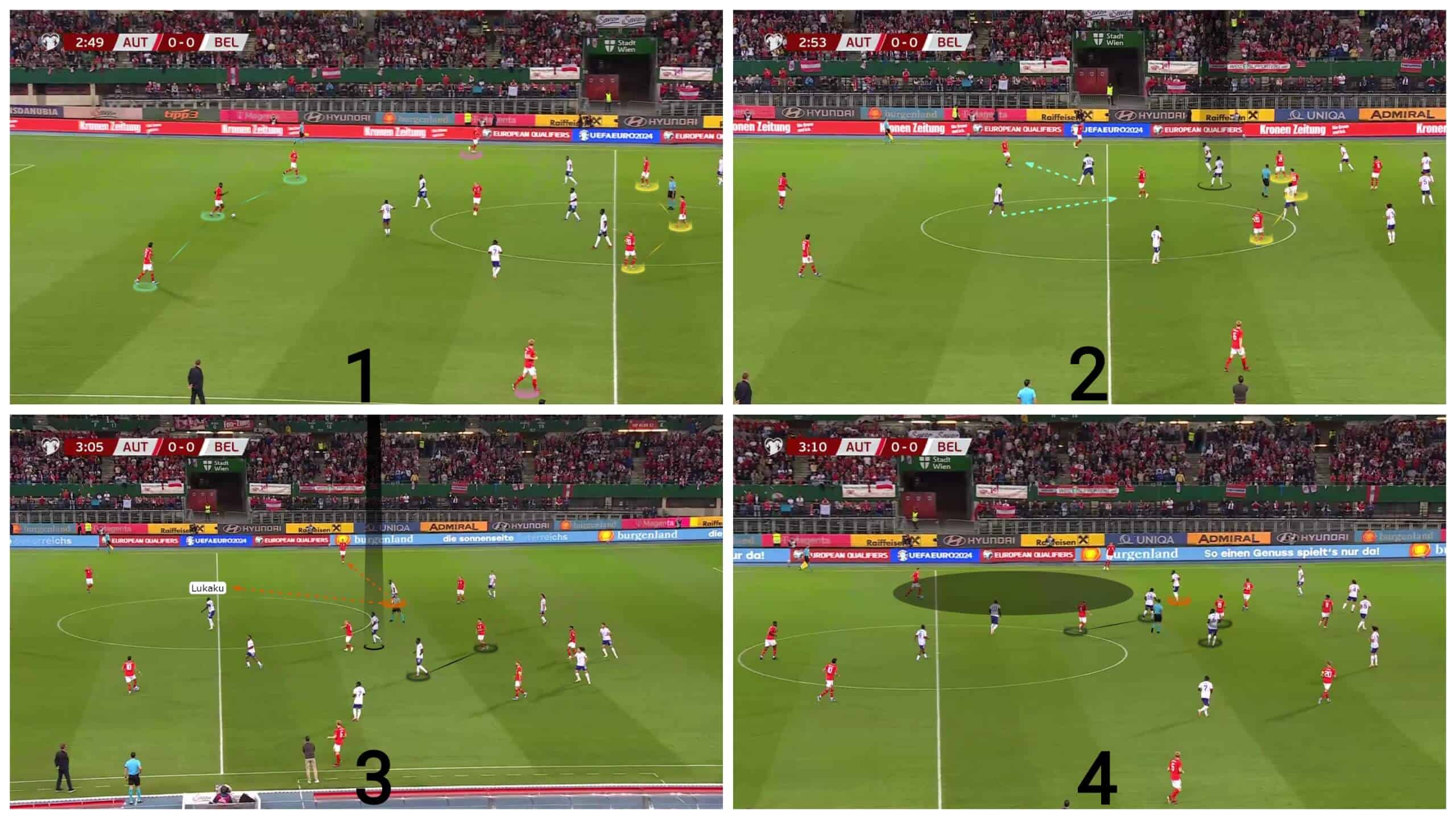
As we have mentioned, you may notice that their ways aren’t really dangerous, and they can only give them more time and space to send crosses longballs, but they may hurt the rushing opponents who may leave this mentioned gap, and we will show how they could find solutions for problems appear during the match, as they did against Germany.
In the first photo below, Germany finds a good way to press them using a 5-2-1-2 formation with the two forwards using a six-centre-back pressure; one presses the centre-back while the other presses the sixer.
Behind them, a free midfielder is ready to press the sixer while shifting the ball from one side to the other, as shown in the second and third photos.
After making sure that the ball goes to one side, this free midfielder goes narrow to cover the middle, as in the fourth photo where it is shown that Germany’s two midfielders press the CAM, 10 position, and the second midfielder who pushes up making Austria’s shape 4-3-3.
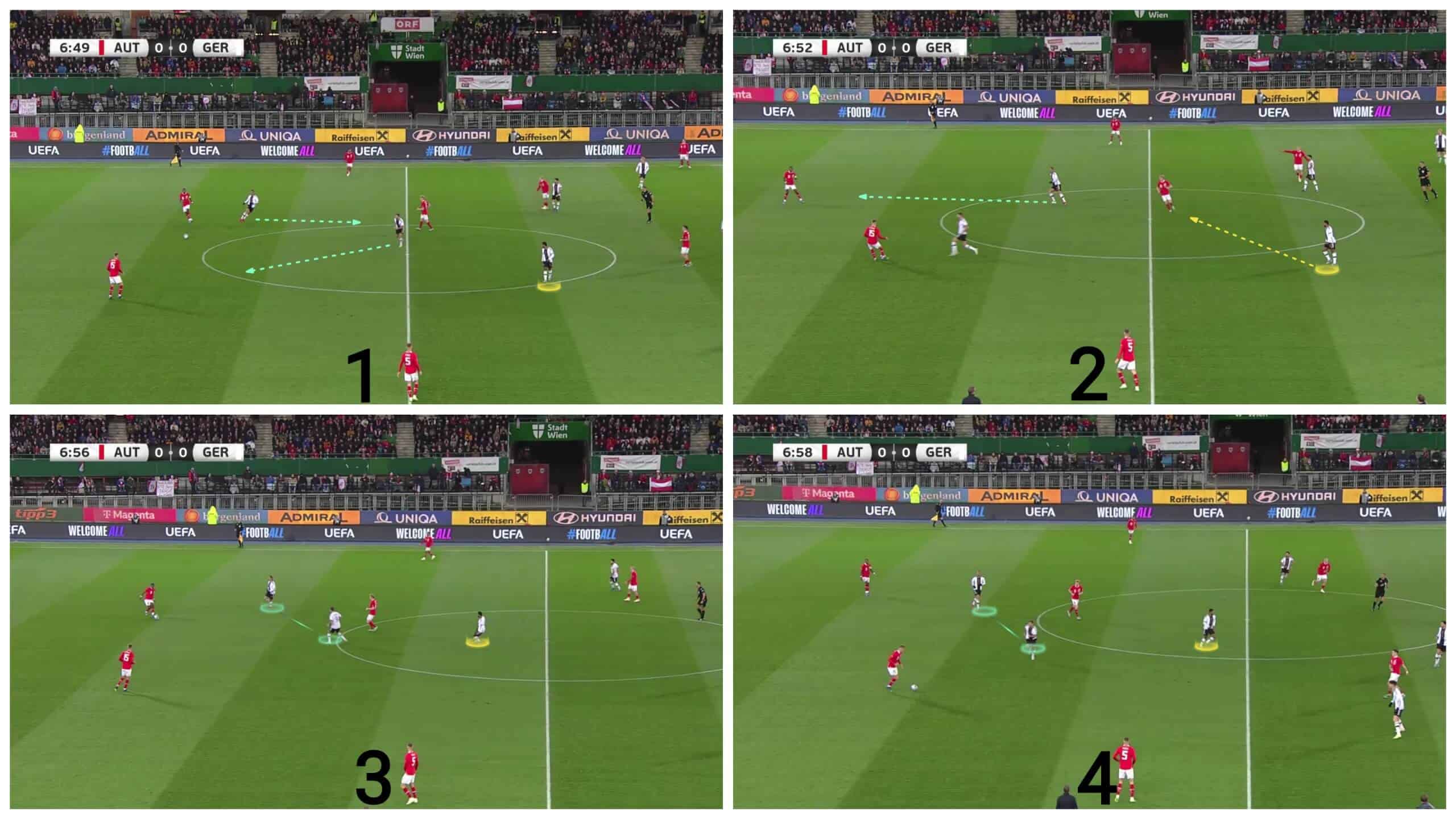
By using the wingback near the ball, in orange, to go up to press the full-back and this free yellow midfielder, Germany are safe.
The defender is forced to play the long ball, as shown below.
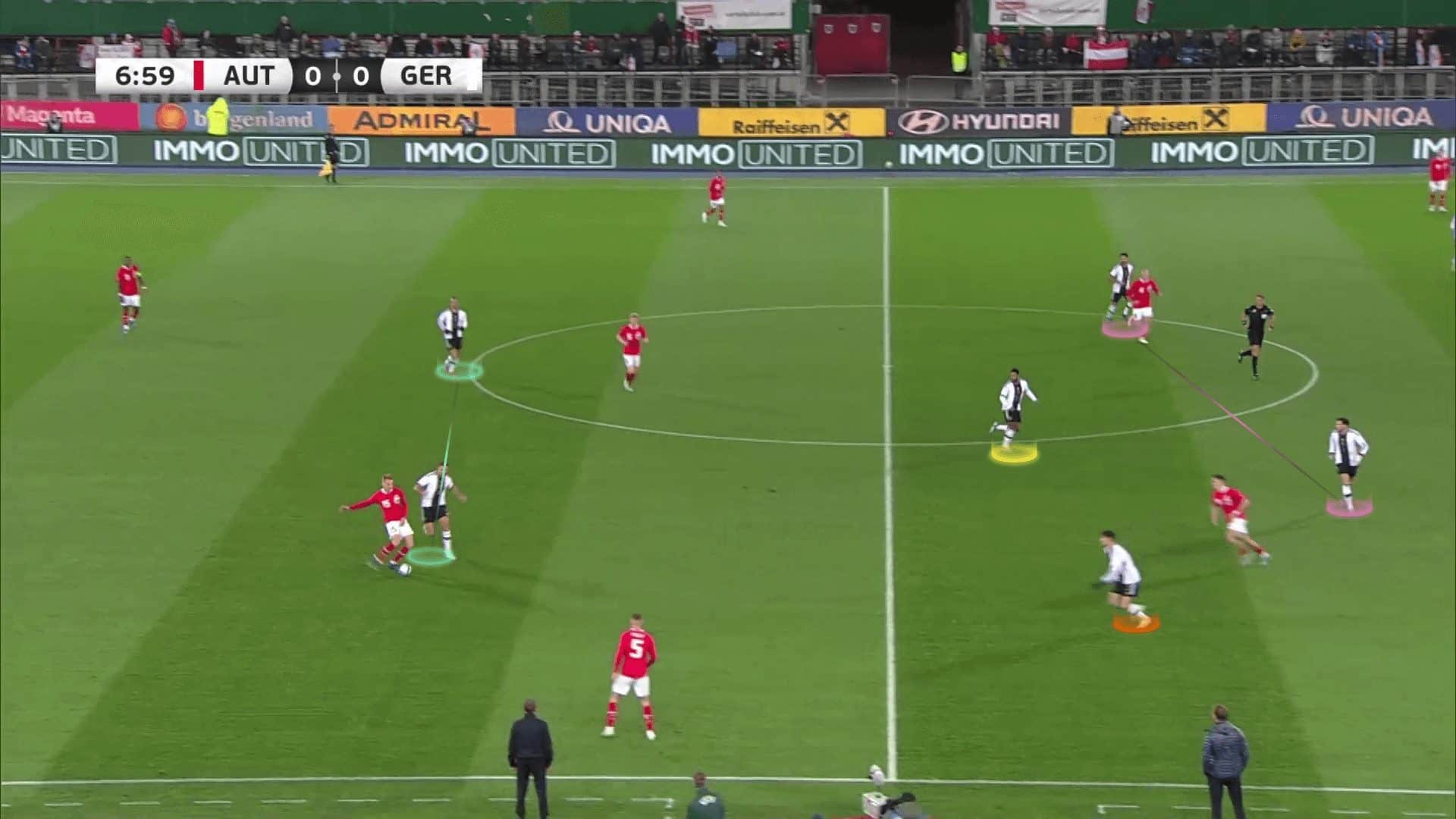
After that, Austria found a counter idea using some manipulations by their joker, Christoph Baumgartner.
Let’s track this process.
In the first photo below, the German 2-1-2 pressing scheme is shown, but why do you think the right midfielder is forced to leave the midfielder behind him to press the full-back? As we have mentioned, the wing-back near the ball should go to push the full-back, but the reason for his absence is clear in the fourth photo.
Christoph Baumgartner, the CAM, leaves the middle to overload the right side.
At the same time, the left winger cuts inside into the central area, so Germany’s defender midfielder can’t leave the central area to chase him, which forces the German LCB to go to him, leaving our wondered wingback with the left ringer.
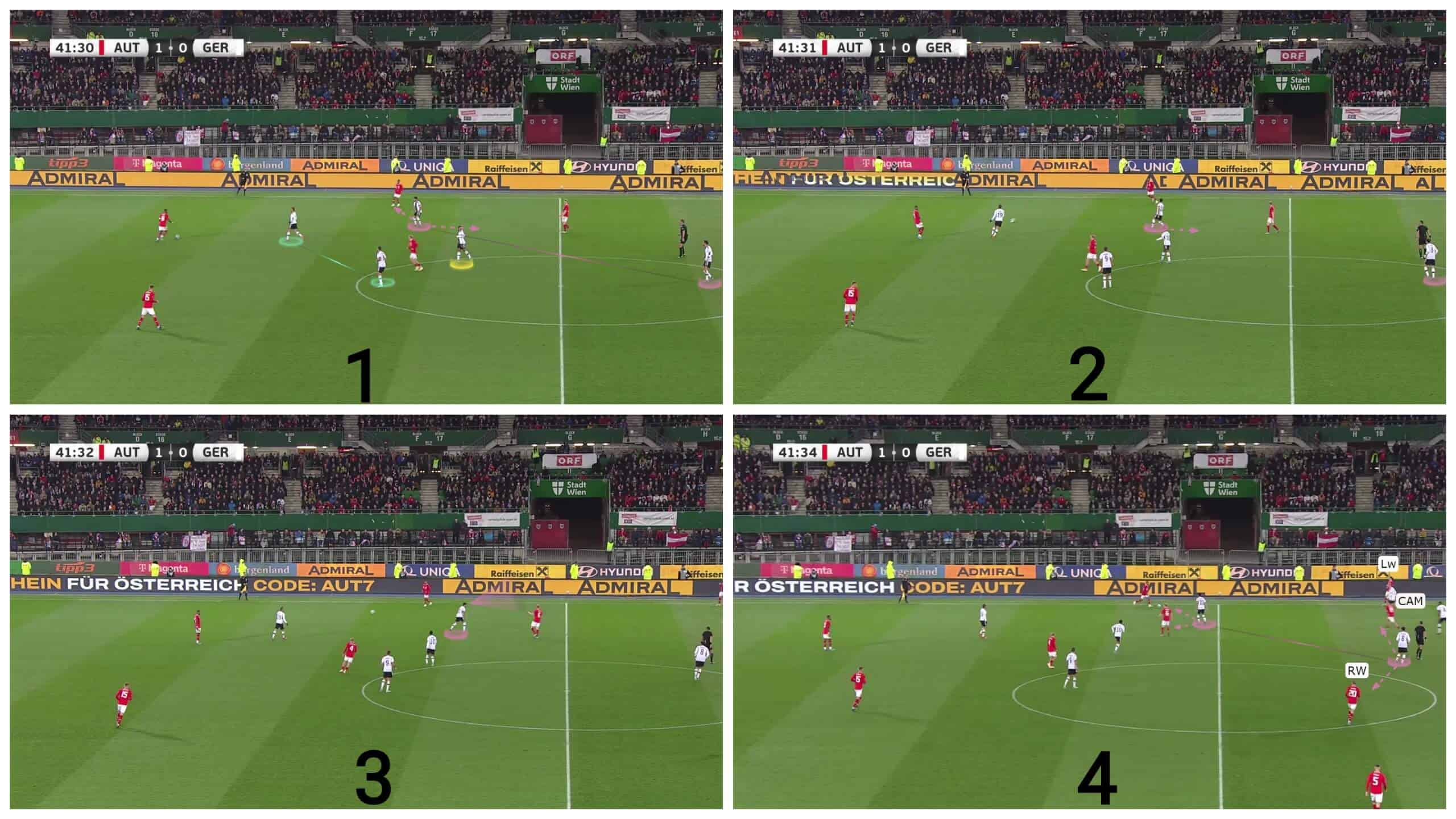
Defensive phase
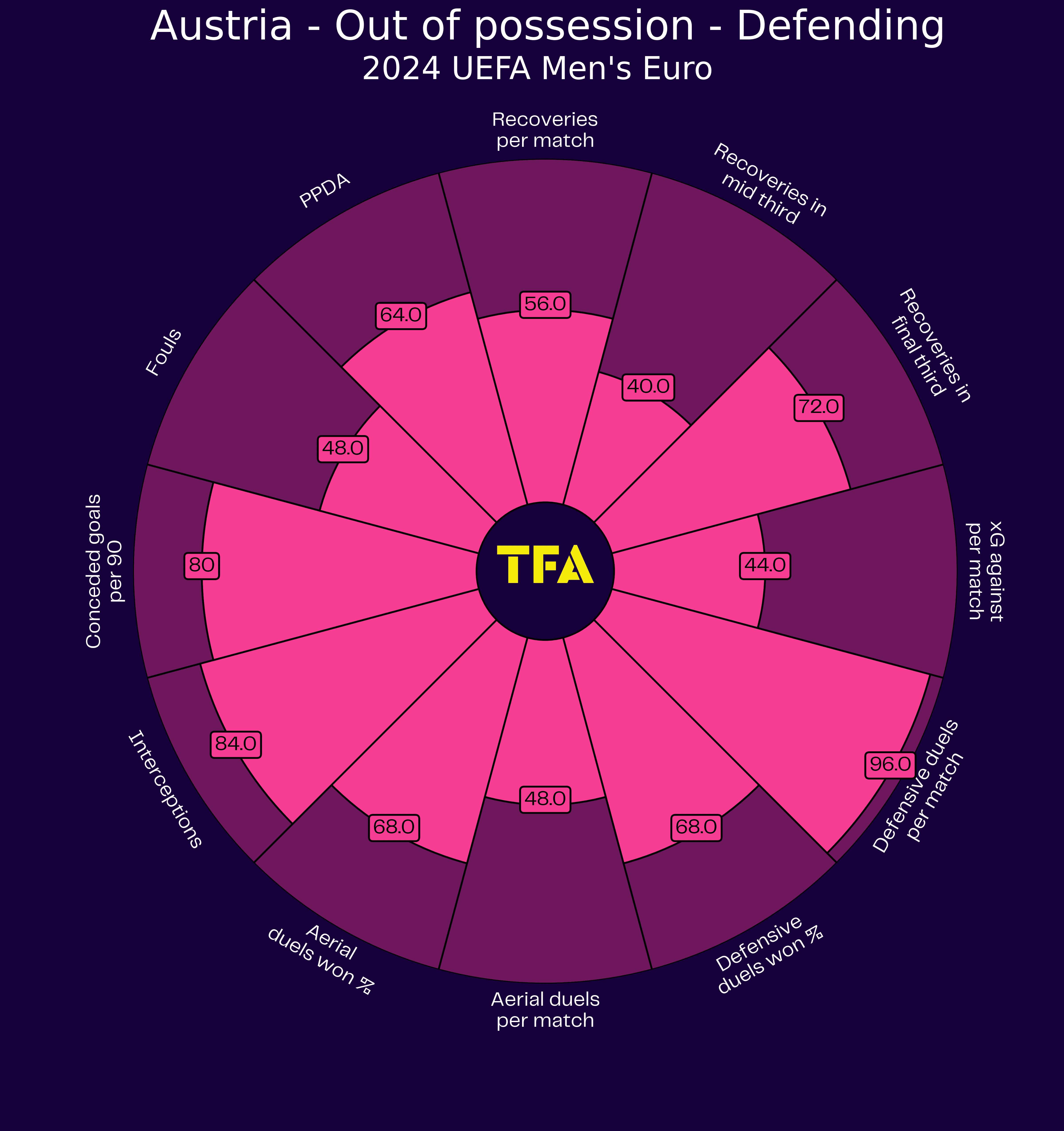
In terms of defensive statistics, the team’s interceptions rank in the 84 percentile, indicating their aggression in pressing and ability to disrupt the opponent’s passing and regain possession, but it is so clear that it happens in the final third, with a 72 percentile showing that they prefer to press highly.
Their PPDA (Passes Per Defensive Action) percentile rank stands at 64, showing a high, moderate level of pressing intensity in relation to their competitors.
You may expect higher numbers because of the previous stats, but we will show that they follow the side-pressing strategy, in which they press toughly but in certain moments.
“What is a little bit of pressing? A little bit of pressing is like a little bit of pregnant.
I mean, either you are pregnant or not.” Ralf Rangnick’s speech on how to press.
That shows how aggressive and intense they are in pressing.
Generally, they prefer to press highly with a side-pressing strategy, as we will explain in detail.
In the first photo below, when the opponent’s defender passes the ball to a side, the attacker in front of him runs in a curved path to prevent the ball from coming again to this side, prevent shifting, to force the opponent into one side where they can press using the pitch lines.
This side pressing helps them to save a free midfielder at the back of these two pressing lines to cover behind them and be able to track any second striker that may drop.
The first two attackers try to stand, cutting the passing lane to the midfielders behind them, covering shadow, while being ready for the mentioned mission; one prevents shifting while the other presses the centre-back who got the ball.
The three yellow line behind them, the two wingers, and one of the two central midfielders stand narrow, waiting for the side the ball goes.
Then, a winger goes to the full-back near the ball, the midfielder goes to one of the opponent’s midfielders, and the far winger joins the middle to press the other midfielder, leaving the far full-back free.
This means they can press six players by using only five players, as shown in the rest of the photos.
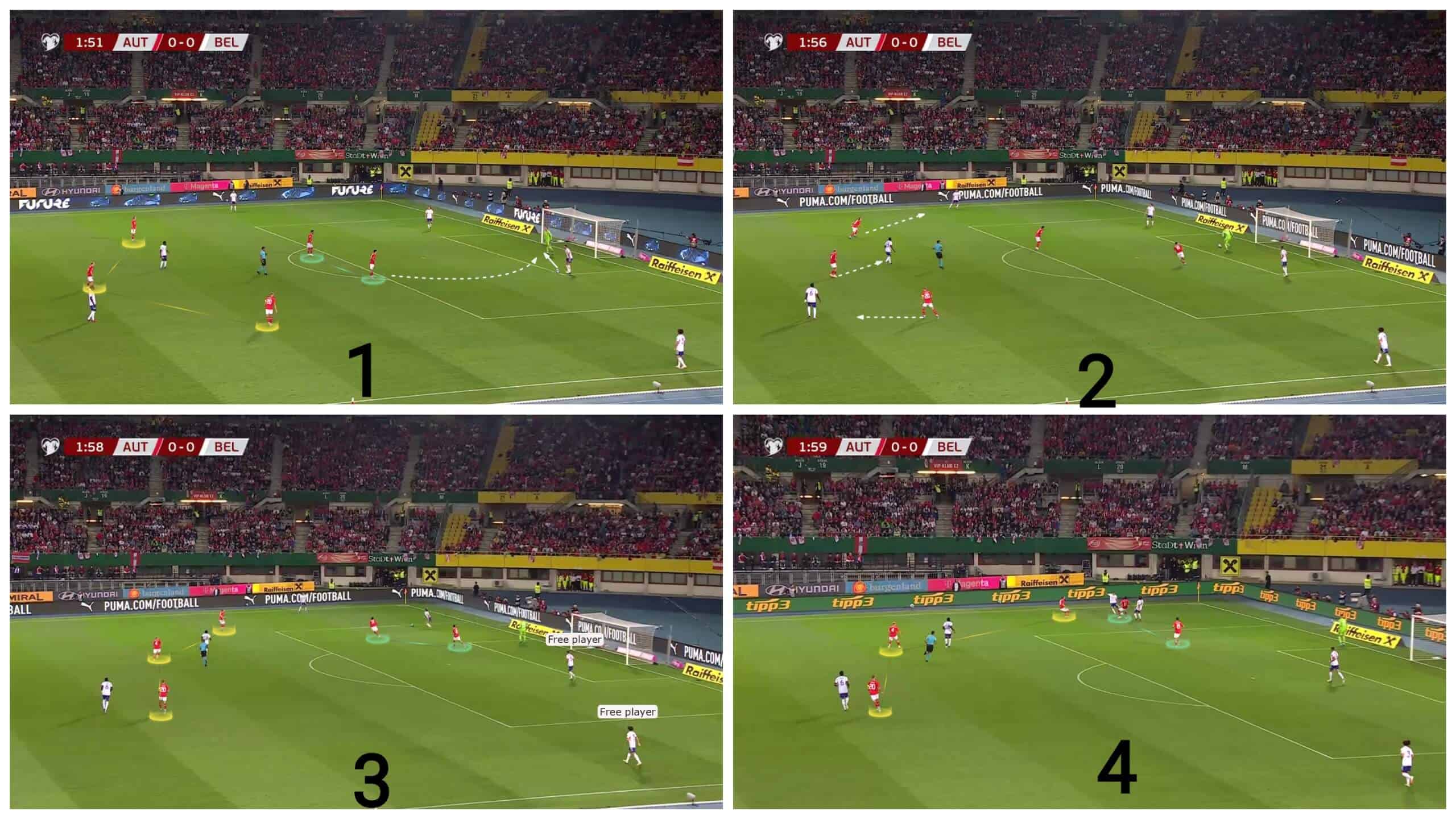
Their first goal against Türkiye comes from a high-pressing phase, showing their aggression when pressing.
In the first photo below, the attacker near the ball didn’t close the passing lane back to the centre-back, as supposed to be in white.
This allowed shifting, and the centre-back could have sent the ball to the far free full-back, as shown in the second photo below.
However, their aggression was so clear that they got the ball, scoring a goal by the very active Xaver Schlager, who they will miss in the Euro.
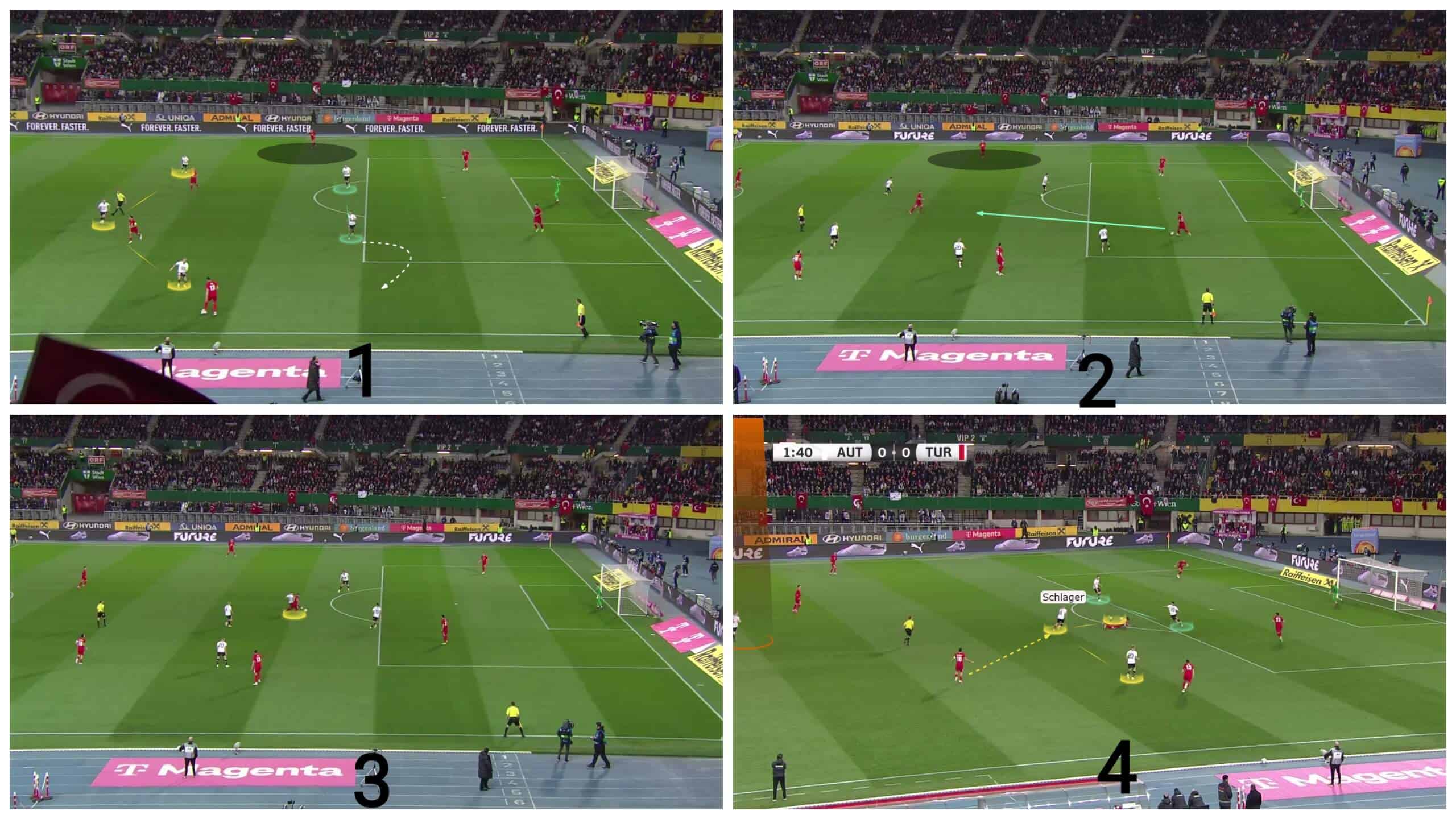
Germany had a counter idea to make the two centre-backs stand widely while the two midfielders more narrowly, which made it difficult for the two strikers to cover shadowing this passing lane, so Germany used two third-man passes to free their right full-back, as shown below.
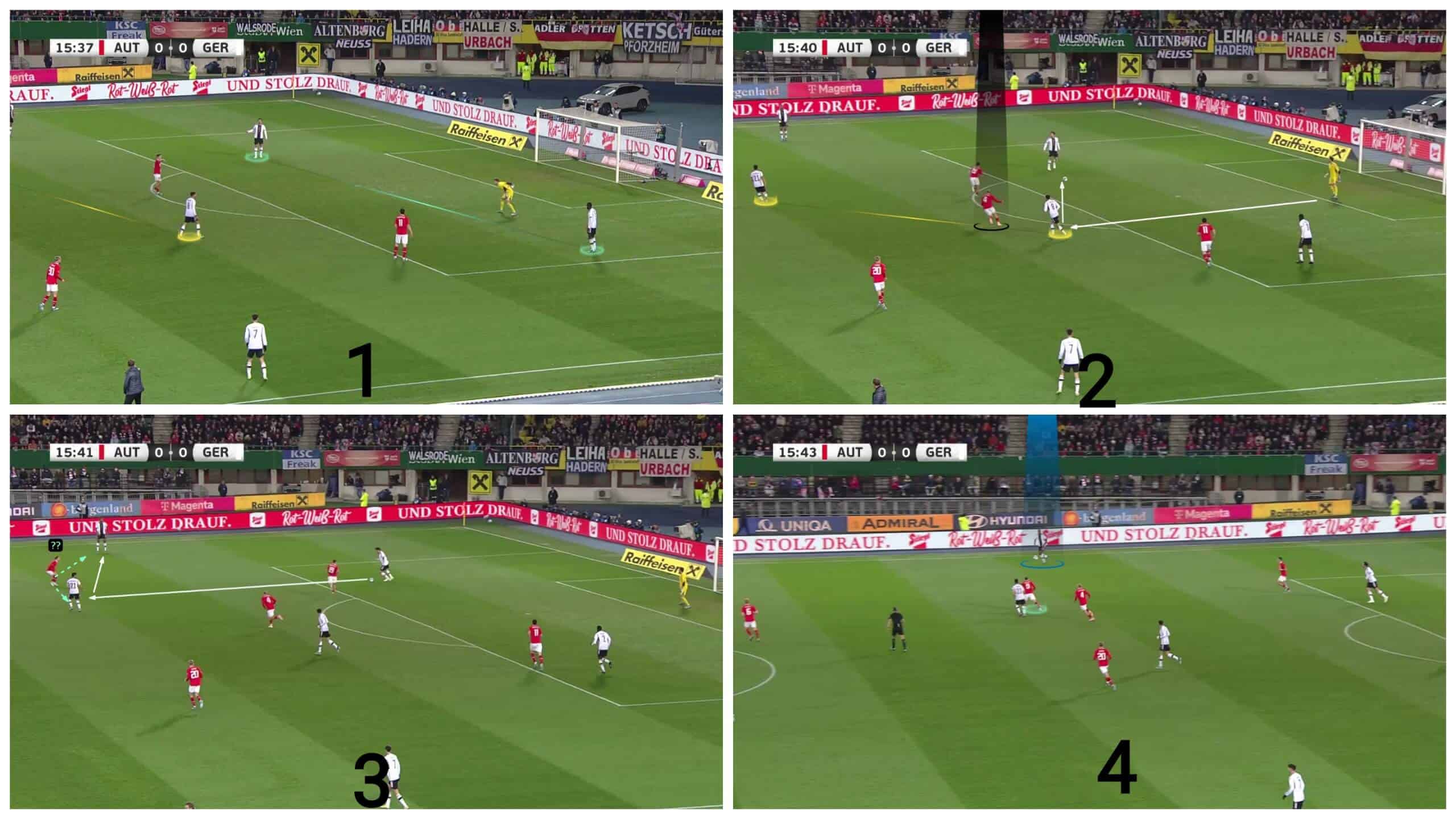
As we have mentioned, Austria is a very active team tactically during the game, so the free-defending midfielder was asked to go up to press the two midfielders in the normal 4-4-2 shape.
However, when the ball goes to a side, one midfielder goes to the back to cover the area behind the pressing while the far winger does the same process to go inside to mark the far midfielder, as shown below.
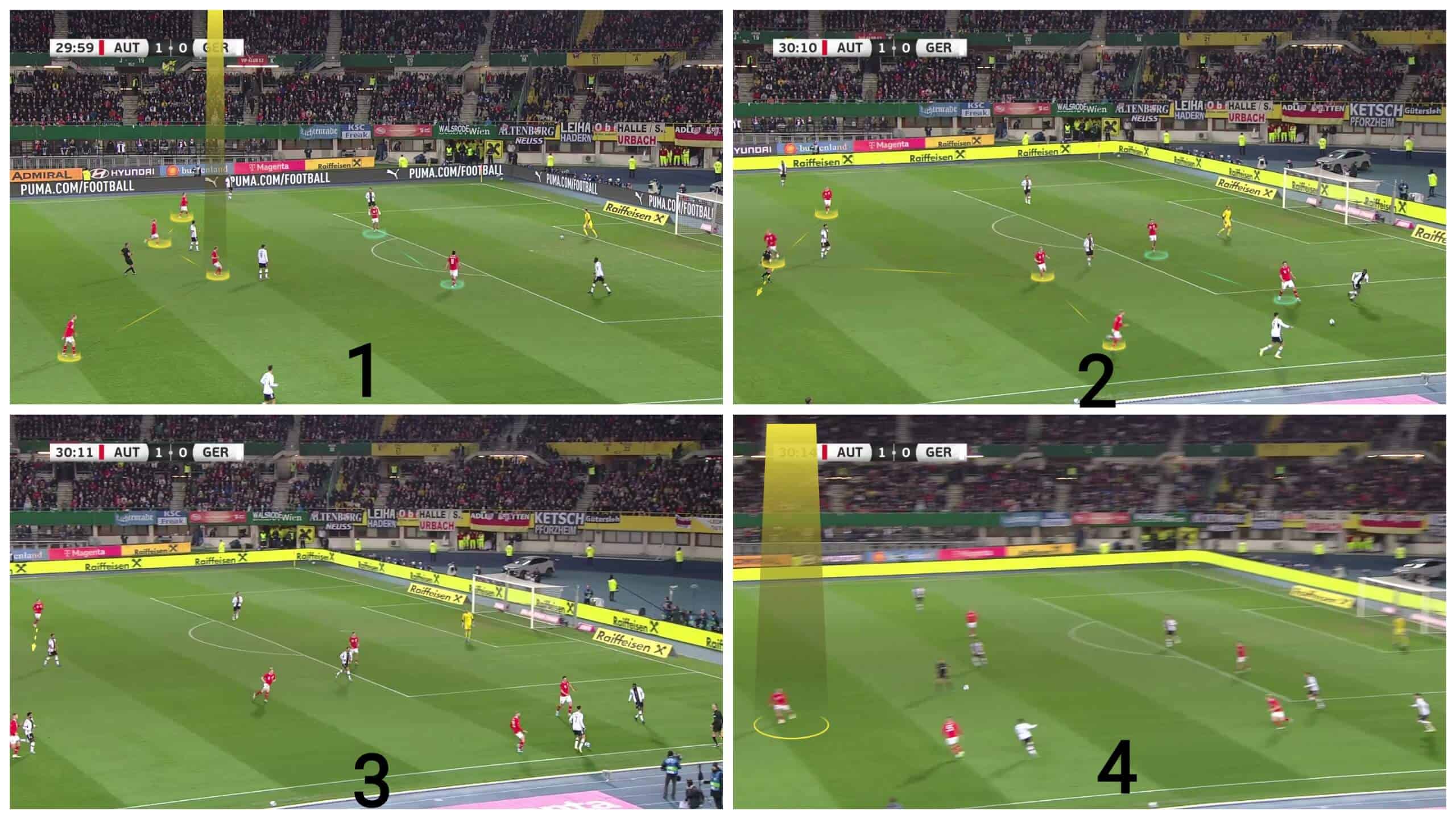
Transitions
In defending transitions, they are brilliant at counterpressing.
In the first photo below, the yellow CAM and the blue central midfielder go quickly to get the ball back, while the holding midfielder has an important role of being close and ready to counterpress, as in the second photo.
In the third photo, the ball is regained after a few seconds, while the right-back also stands narrow, as in the fourth photo, in white.
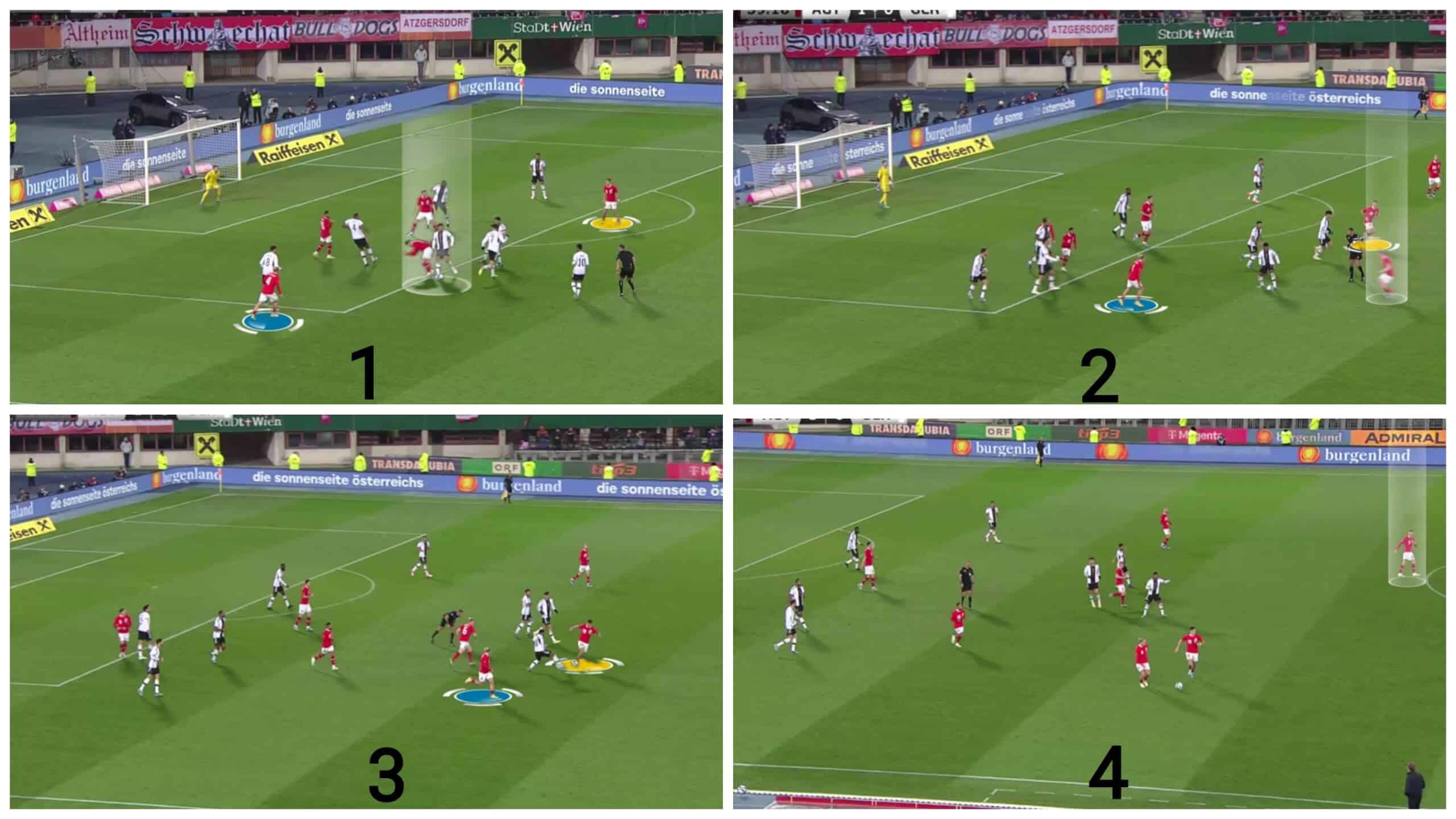
In attacking transitions, they exploit their 4-4-1-1 shape, making Christoph Baumgartner their escape point.
He stands in the middle brilliantly, getting close to any possible loose ball, and then he has a brilliant ability to dribble with the ball, doing some passing combinations with the two yellow wingers, as shown below.
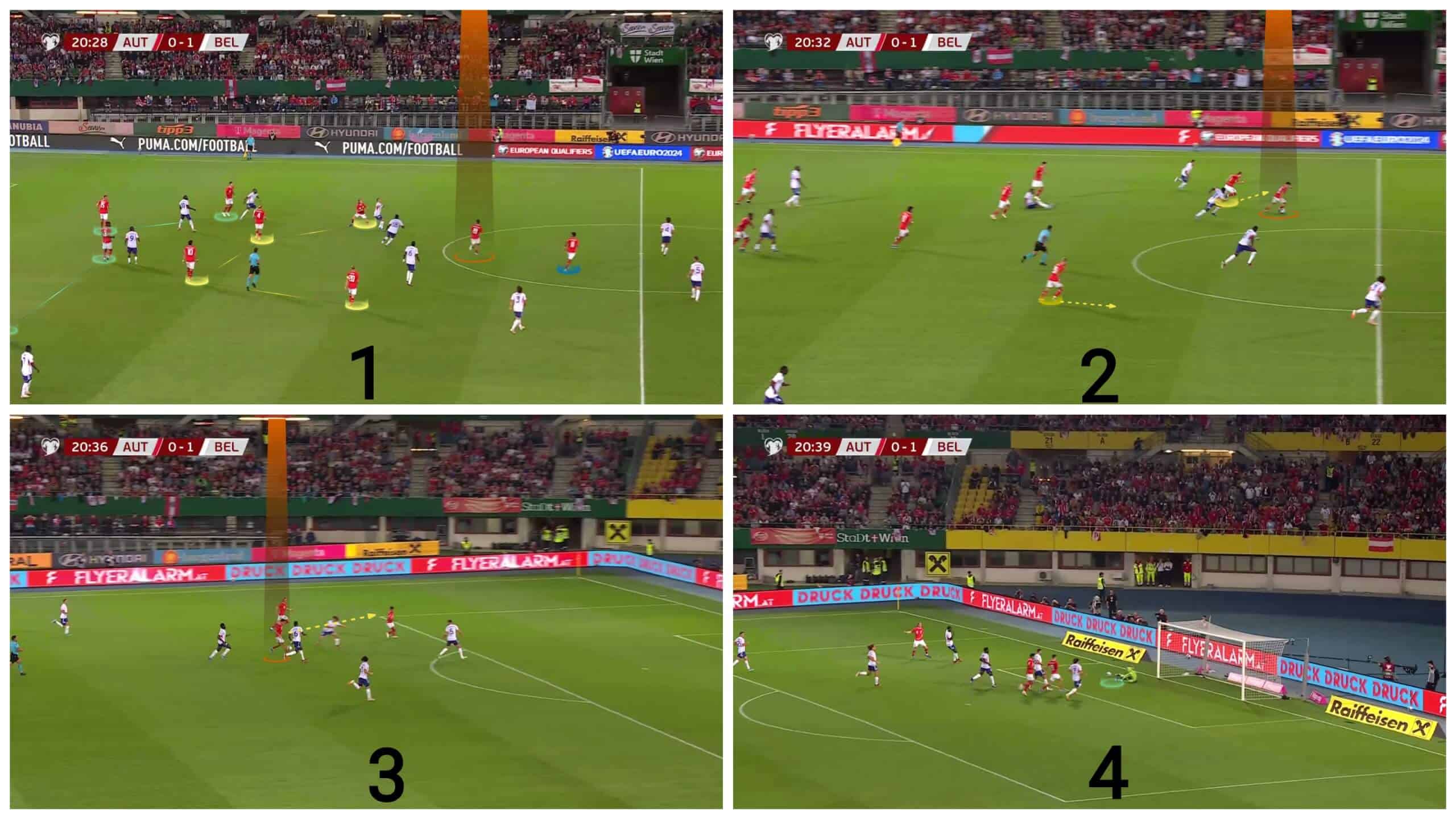
He has also a vital role in going to the ball side, helping his mate to escape from pressing and then, he exploits his vision to send the ball to the other empty side, as shown in the two photos below.
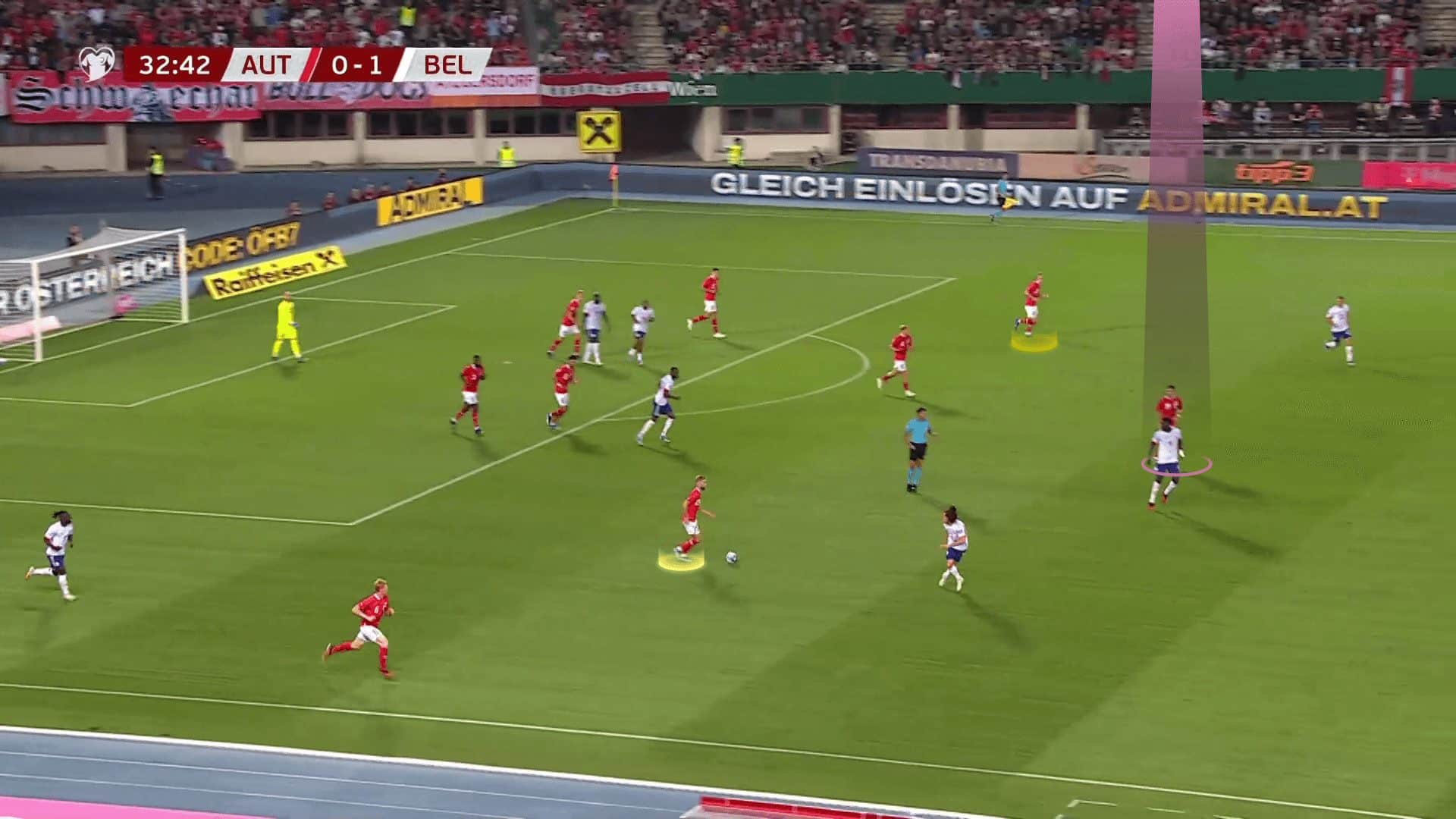
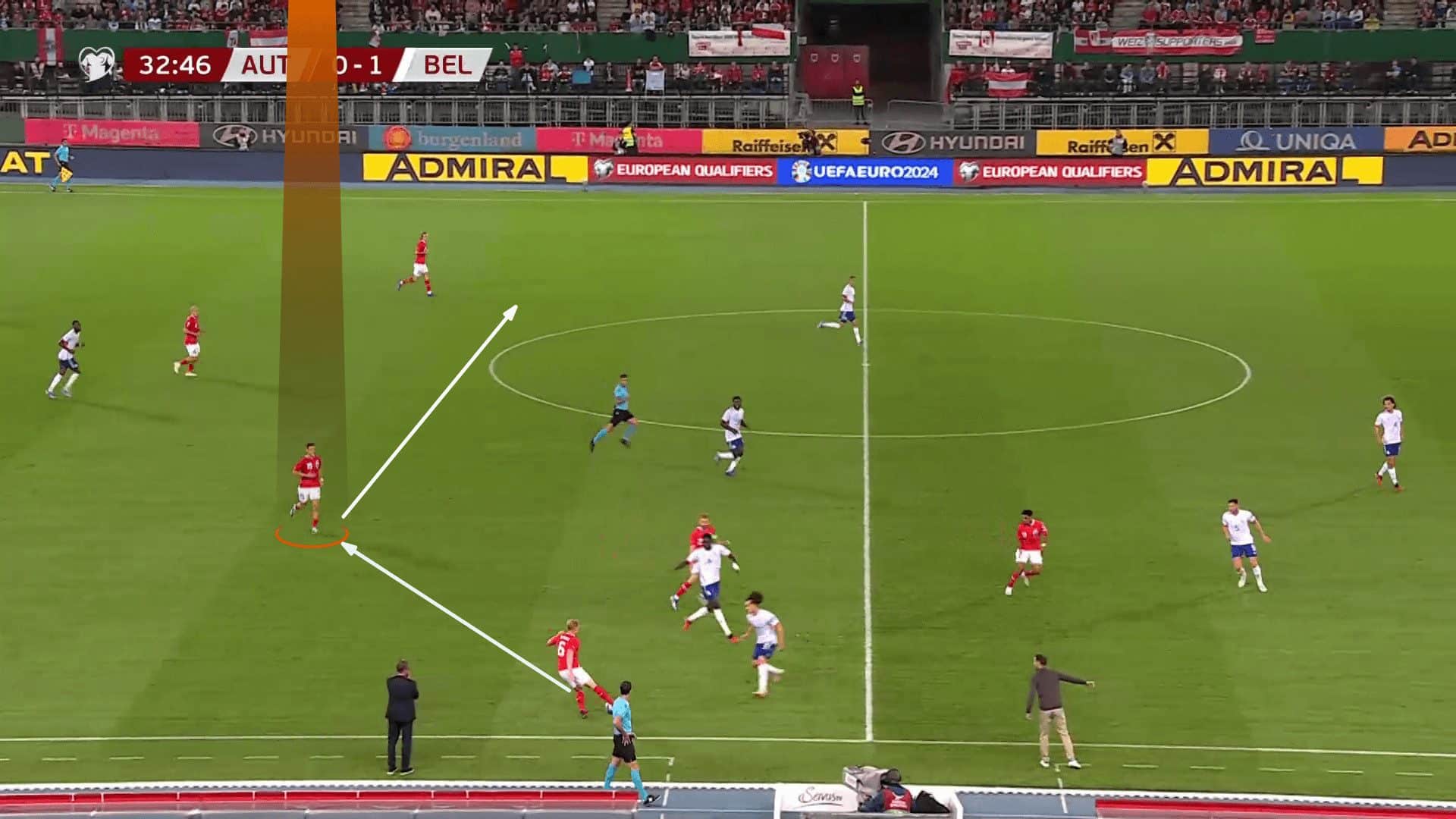
Forwards
The German coach usually asks his wingers to cut inside in the flanks, so he usually uses Konrad Laimer and Marcel Sabitzer as right and left-wingers.
He may also make Romano Schmid replace one of them, putting one as a midfielder.
This varies depending on the opponent, the game plan and the tactical battles during the games.
Michael Gregoritsch is the probable first choice as a striker, especially after the expected absence of Manprit Sarkaria and Sasa Kalajdzic due to injuries.
When a speed attacker is needed, Muhammed Cham and Sasa Kalajdzic are good options, and he can also use one of the wingers.
Midfielders
The midfield in Austria’s system plays a dynamic and significant role due to its fluidity and awareness.
As we have mentioned, they have essential roles in pressing and attacking.
Regarding the two midfielders, Ralf Rangnick relies on Nicolas Seiwald as one of the central players because of his defensive power and aggression, but the remaining question is who will be beside him instead of Xaver Schlager.
Florian Grillitsch may be the best choice, while Konrad Laimer and Marcel Sabitzer are also good options.
In front of them, maestro Christoph Baumgartner will cover them when needed to help all of them attack or defend.
Defenders
With the absence of David Alaba and Philipp Lienhart, the German coach will probably exploit Maximilian Wöber’s ability to play as a centre-back instead of the left-back position, as he did against Turkey, to be beside Kevin Danso.
This may be useful because he would put Phillipp Mwene and Stefan Posch as full-backs because he likes his full-backs to stand widely, and that will fit with their attacking weapons.
Key player
You may have predicted their key player.
Christoph Baumgartner has much potential to make us see that he may be Austria’s key player.
The first thing we should mention that his balance; he is a 24-year-old player, which means he is a bit young and active, but with good experience.
The graph below shows his balance in attacking and defending, knowing that he can play as a winger, too.
With an 80.3 percentile, he is good at defensive duels, showing that his aggression and effectiveness are possible.
Due to his physical ingredients, he is at the 66.6 percentile at aerial duels won, but seeing his aerial duels per 90, 89.8 percentile, it is clear that he intends to get into physical clashes.
With a 96.7 percentile of positioning, he is very good at interceptions and tackles.
Attacking, he has the role to get into the box to be beside the attacker and contribute in goals or assist as an essential role for the 10th position, and you can find it clearly in “goal contribution per 90” and “Opp penalty area touches per 90” terms.
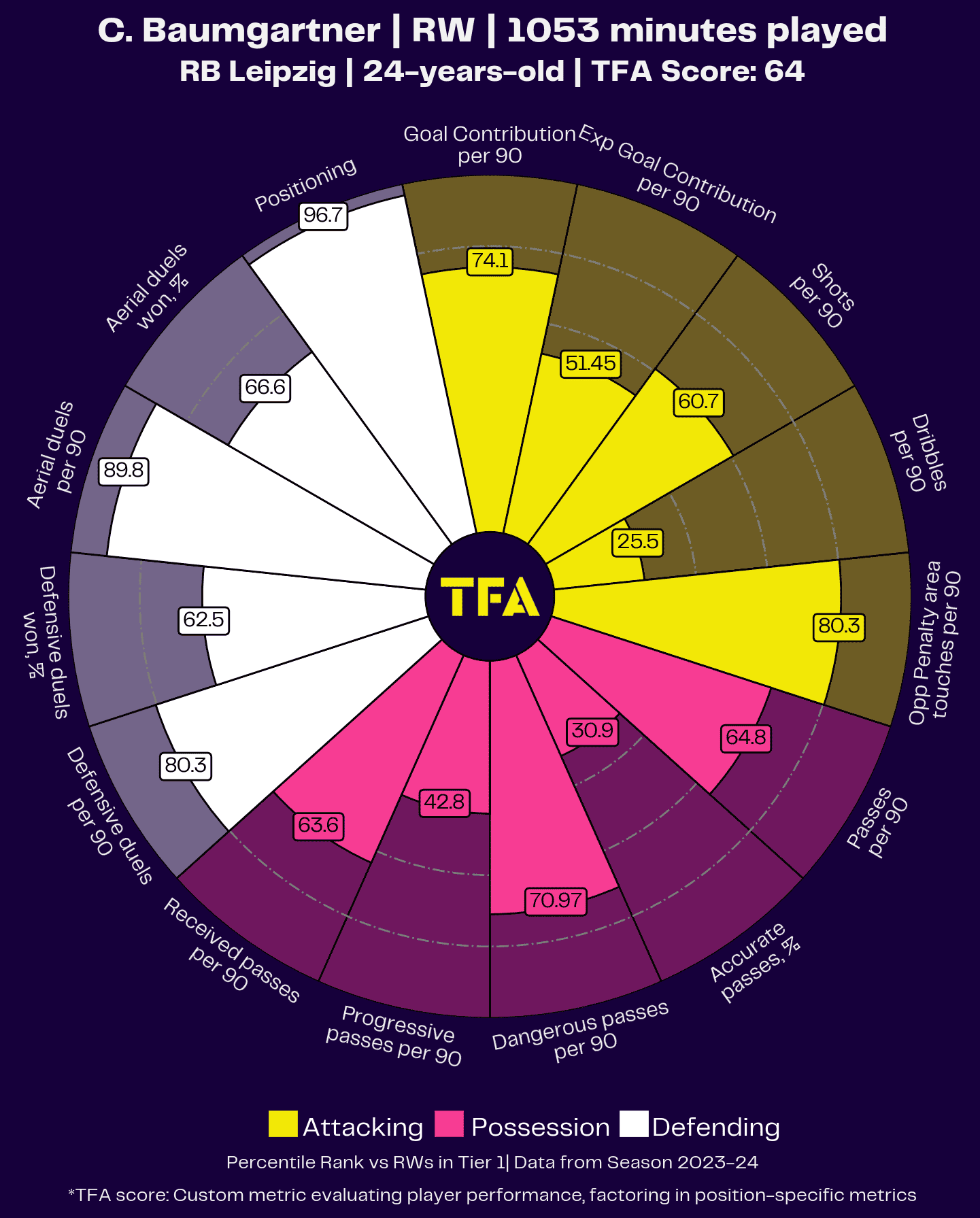
The most important thing we should say about him is that he is very suitable to their way of play and we have already mentioned that his several roles which he does brilliantly.
Defensively, we have mentioned that he pushes up to press with the striker in the first line with important awareness to close passing lanes and prevent shifting.
Attackingly, we have mentioned that he moves to compose gaps in the opponent’s defence while his coach can do some manipulations with his flexible movements.
We have also said that he is the escape point for his team in attacking transitions.
In the photo below, he brilliantly moves away from the opponent’s sixer, who hesitates to follow him in such a far area.
He offers help to the ball carrier standing behind the pressing opponent to make him hesitate to press.
If he decides to press, he will move to open a passing lane, receive the ball, pass and move, as shown below.
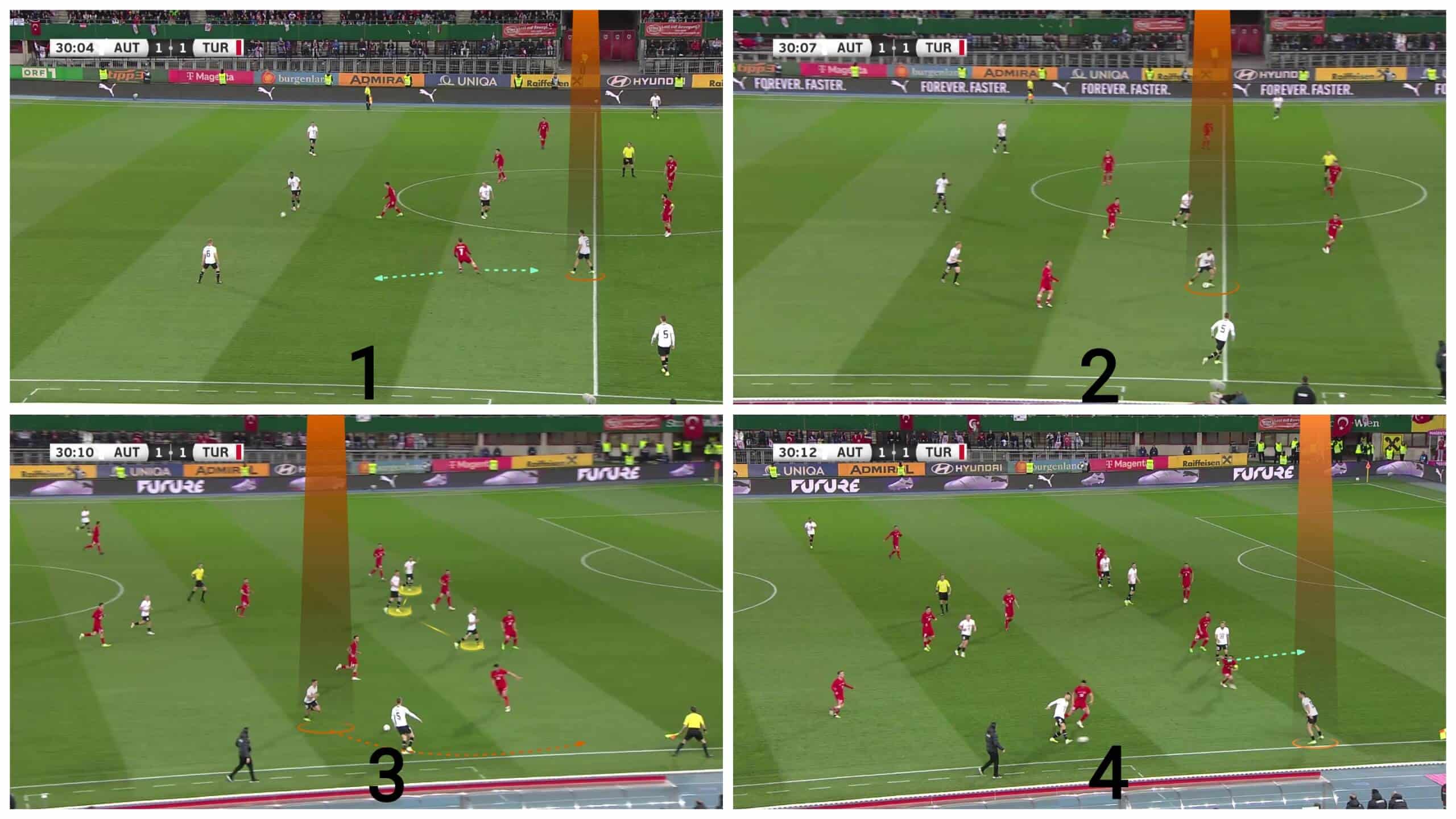
In the end, the defender is forced to commit a foul, as shown below.
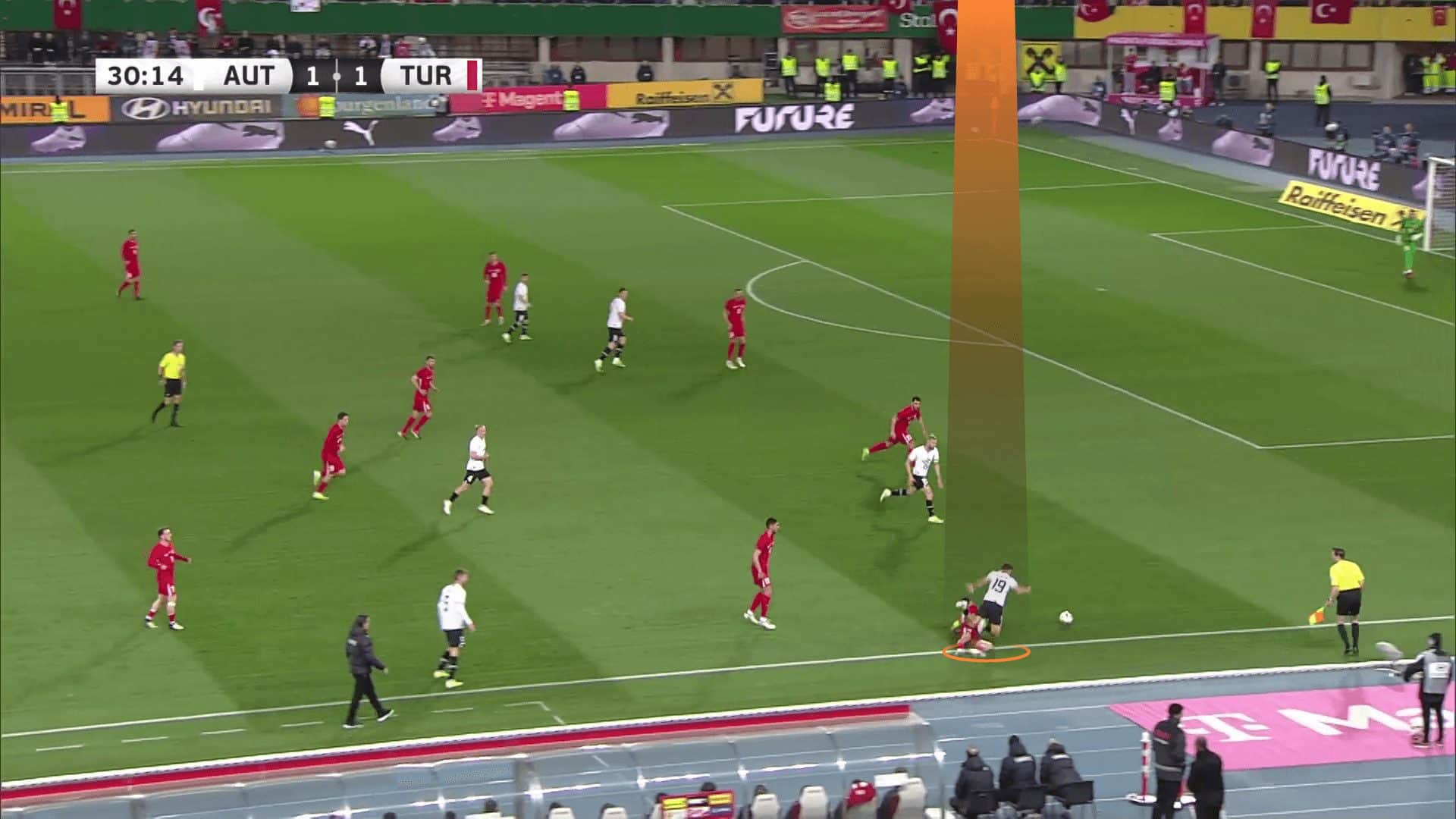
Tournament Prediction
It is difficult to predict in such a tough group, but let’s say that France and the Netherlands may hold the first two positions in that group, in theory.
Austria can qualify as a third, at least, while Poland may come last.
However, we should mention that Austria is good at direct tactical battles, and we think that high-press and transition phases may be vital factors in this group, as explained in this analysis.
What makes us hesitate in prediction is the many injuries that will force the coach to make many unexpected changes, which may succeed or fail—we wait to see whether the changes will be with the players only or may include the tactics!

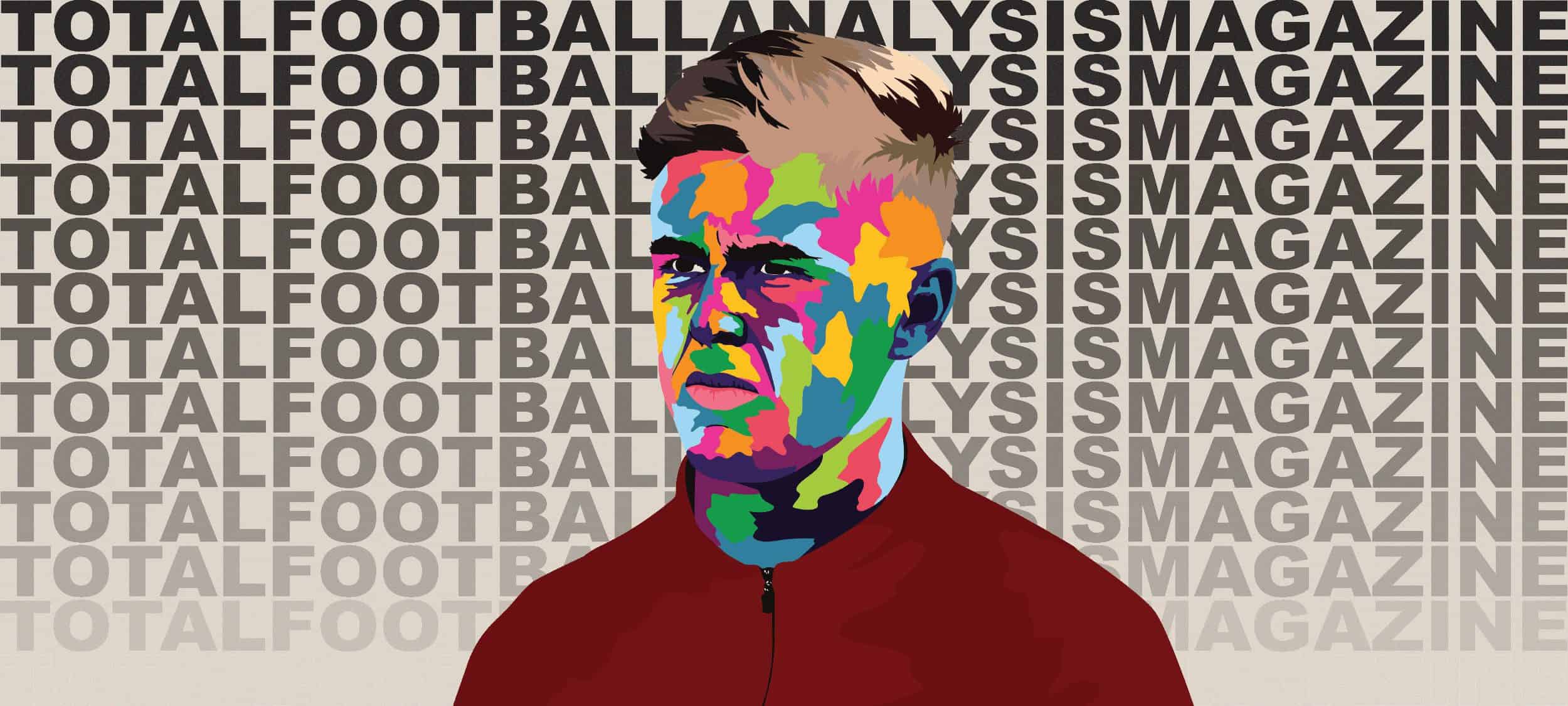




Comments